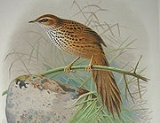
Fernbird
Encyclopedia
The Fernbird is an insectivorous
bird
endemic
to New Zealand
. The Māori names are Kōtātā or Mātātā. It is a rich brown above and white below, with brown spots on both the throat and breast. Early settlers called it the "Swamp Sparrow" no doubt because of its colouration. The tail feathers are thin, dark brown, and spine-like. The birds reach a length of 18 cm (7 in) - as measured from tip of beak to end of tail. However,almost half of that is tail
The Fernbird is a ground-dwelling bird, and is a reluctant flier, travelling mainly on foot or in occasional short flights of less than 15 metres. In the 19th century Buller
described it as "one of our most common" (birds) but it has been adversely affected by the subsequent widespread destruction
of its natural (wetland) habitat following European settlement and is now rare
There are six fully protected sub-species of Fernbird:
Bowdleria (punctata) rufescens (the Chatham Islands Fernbird
) is believed to have become extinct circa 1900.
The birds nest in sedges or other vegetation close to the ground, making a deep woven cup of dried rushes lined with feathers. Breeding occurs from September to February, producing clutches of 2-3 pinkish-white eggs with brown or purple speckles.
Insectivore
An insectivore is a type of carnivore with a diet that consists chiefly of insects and similar small creatures. An alternate term is entomophage, which also refers to the human practice of eating insects....
bird
Bird
Birds are feathered, winged, bipedal, endothermic , egg-laying, vertebrate animals. Around 10,000 living species and 188 families makes them the most speciose class of tetrapod vertebrates. They inhabit ecosystems across the globe, from the Arctic to the Antarctic. Extant birds range in size from...
endemic
Endemic (ecology)
Endemism is the ecological state of being unique to a defined geographic location, such as an island, nation or other defined zone, or habitat type; organisms that are indigenous to a place are not endemic to it if they are also found elsewhere. For example, all species of lemur are endemic to the...
to New Zealand
New Zealand
New Zealand is an island country in the south-western Pacific Ocean comprising two main landmasses and numerous smaller islands. The country is situated some east of Australia across the Tasman Sea, and roughly south of the Pacific island nations of New Caledonia, Fiji, and Tonga...
. The Māori names are Kōtātā or Mātātā. It is a rich brown above and white below, with brown spots on both the throat and breast. Early settlers called it the "Swamp Sparrow" no doubt because of its colouration. The tail feathers are thin, dark brown, and spine-like. The birds reach a length of 18 cm (7 in) - as measured from tip of beak to end of tail. However,almost half of that is tail
The Fernbird is a ground-dwelling bird, and is a reluctant flier, travelling mainly on foot or in occasional short flights of less than 15 metres. In the 19th century Buller
Walter Buller
Walter Lawry Buller KCMG was a New Zealand lawyer, naturalist and ornithologist.Buller was the author of A History of the Birds of New Zealand , with illustrations by John Gerrard Keulemans. In 1882 he produced the Manual of the Birds of New Zealand as a cheaper, popular alternative...
described it as "one of our most common" (birds) but it has been adversely affected by the subsequent widespread destruction
Habitat destruction
Habitat destruction is the process in which natural habitat is rendered functionally unable to support the species present. In this process, the organisms that previously used the site are displaced or destroyed, reducing biodiversity. Habitat destruction by human activity mainly for the purpose of...
of its natural (wetland) habitat following European settlement and is now rare
There are six fully protected sub-species of Fernbird:
- Bowdleria punctata punctata (South Island Fernbird)
- Bowdleria punctata vealeae (North Island Fernbird)
- Bowdleria punctata stewartiana (Stewart Island Fernbird)
- Bowdleria punctata wilsoni (Codfish Island Fernbird)
- Bowdleria punctata caudata (Snares Fernbird)
- Bowdleria punctata insularis.
Bowdleria (punctata) rufescens (the Chatham Islands Fernbird
Chatham Islands Fernbird
The Chatham Islands Fernbird is an extinct bird species endemic to Pitt Island and Mangere Island . Its next living relatives are the Snares Fernbird and the New Zealand Fernbird or Matata...
) is believed to have become extinct circa 1900.
The birds nest in sedges or other vegetation close to the ground, making a deep woven cup of dried rushes lined with feathers. Breeding occurs from September to February, producing clutches of 2-3 pinkish-white eggs with brown or purple speckles.

